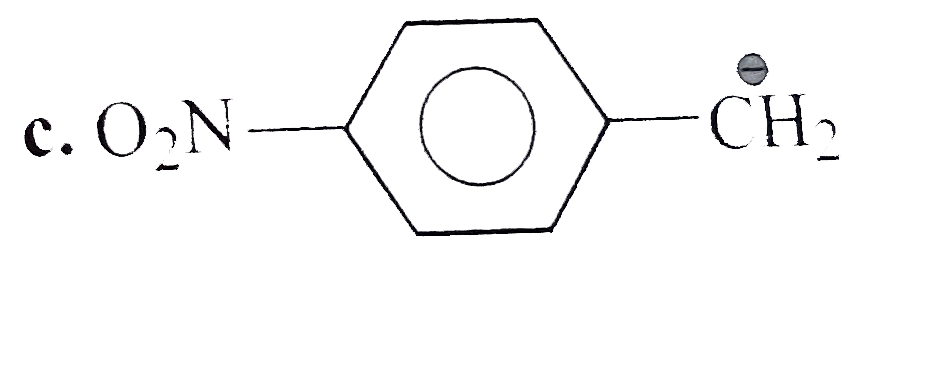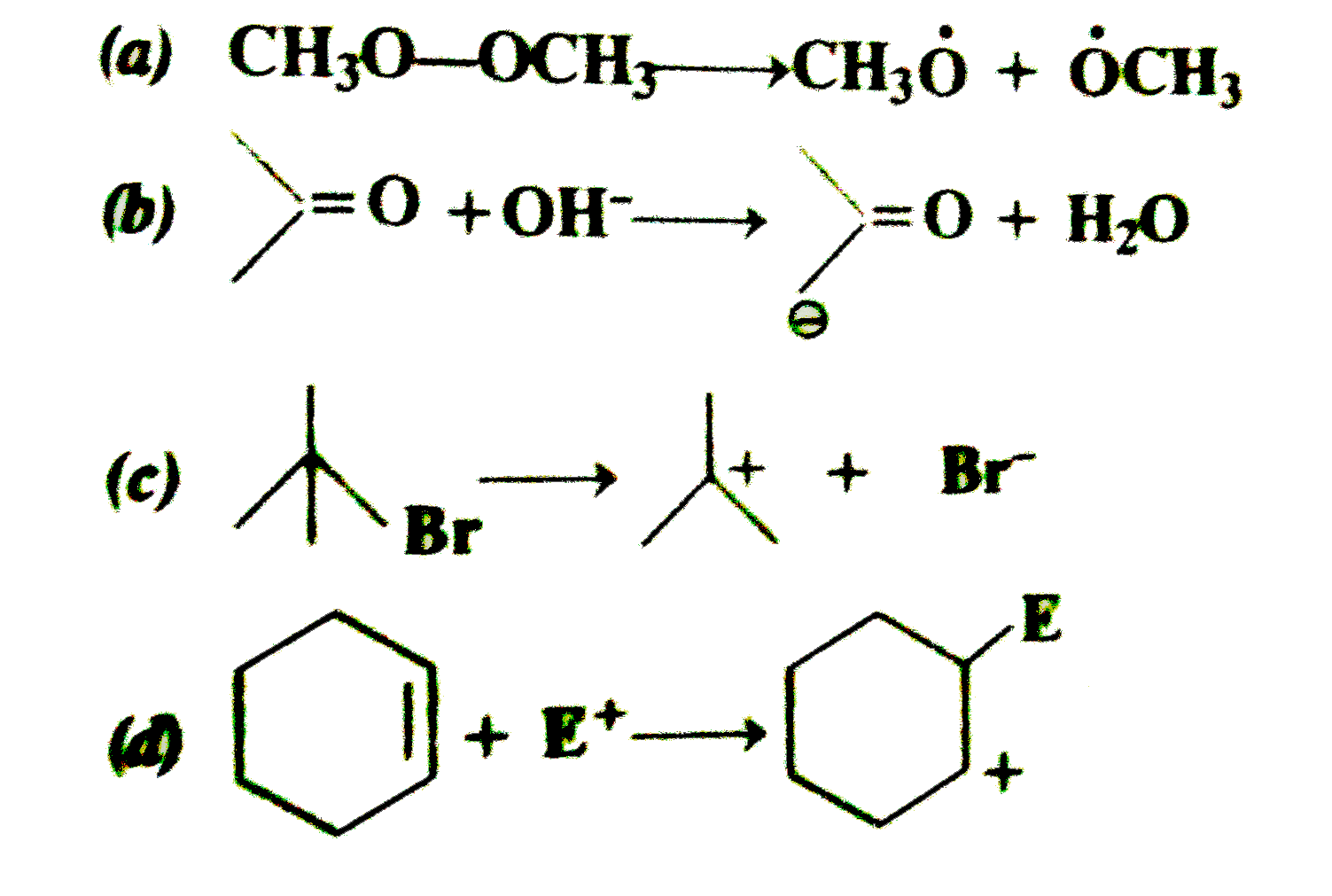An organic reaction occurs by using reagents called electrophiles and nucleophiles via the formation of some reactive intermediates called carbocations, carbanions, free radicals, carbenes, nitrenes, radical cations, and radical anions.
The most stable carbanion is :
PhCH2ӨCH2
PhӨCH2


The correct Answer is:C
To determine the most stable carbanion from the given options, we need to analyze the stability factors affecting carbanions, specifically the effects of substituents on the carbanion.
1. Understanding Carbanion Stability:
- Carbanions are negatively charged species where a carbon atom has three bonds and a lone pair of electrons. Their stability is influenced by the presence of electron-withdrawing or electron-donating groups.
- The stability of carbanions increases with the presence of groups that can stabilize the negative charge through resonance (−M effect) or inductive effects (−I effect).
2. Identifying Effects:
- −M Effect (Mesomeric Effect): Stabilizes the carbanion through resonance. Groups that can donate or withdraw electrons through resonance will affect stability.
- −I Effect (Inductive Effect): Stabilizes the carbanion by pulling electron density away from the negatively charged carbon atom. Electron-withdrawing groups enhance stability, while electron-donating groups decrease stability.
3. Analyzing the Options:
- Let’s denote the options as A, B, C, and D, and analyze them based on their substituents.
- Option A: Contains a substituent that only exhibits a −I effect. The lack of resonance stabilization makes this carbanion less stable.
- Option B: Contains a phenyl group that can participate in resonance, providing a −M effect. This increases the stability of the carbanion compared to option A.
- Option C: Contains a substituent that exhibits both −M and −I effects. This dual stabilization makes this carbanion more stable than those in options A and B.
- Option D: Contains an electron-withdrawing group that exhibits a −I effect but is less effective than the groups in options B and C.
4. Conclusion:
- Comparing the stability effects, it is clear that Option C, which exhibits both −M and −I effects, provides the most stabilization for the carbanion. Therefore, the most stable carbanion is from Option C.
Final Answer:
The most stable carbanion is from Option C.
- Carbanions are negatively charged species where a carbon atom has three bonds and a lone pair of electrons. Their stability is influenced by the presence of electron-withdrawing or electron-donating groups.
- The stability of carbanions increases with the presence of groups that can stabilize the negative charge through resonance (−M effect) or inductive effects (−I effect).
- −M Effect (Mesomeric Effect): Stabilizes the carbanion through resonance. Groups that can donate or withdraw electrons through resonance will affect stability.
- −I Effect (Inductive Effect): Stabilizes the carbanion by pulling electron density away from the negatively charged carbon atom. Electron-withdrawing groups enhance stability, while electron-donating groups decrease stability.
- Let’s denote the options as A, B, C, and D, and analyze them based on their substituents.
- Option A: Contains a substituent that only exhibits a −I effect. The lack of resonance stabilization makes this carbanion less stable.
- Option B: Contains a phenyl group that can participate in resonance, providing a −M effect. This increases the stability of the carbanion compared to option A.
- Option C: Contains a substituent that exhibits both −M and −I effects. This dual stabilization makes this carbanion more stable than those in options A and B.
- Option D: Contains an electron-withdrawing group that exhibits a −I effect but is less effective than the groups in options B and C.
- Comparing the stability effects, it is clear that Option C, which exhibits both −M and −I effects, provides the most stabilization for the carbanion. Therefore, the most stable carbanion is from Option C.
The most stable carbanion is from Option C.
Topper's Solved these Questions
- GENERAL ORGANIC CHEMISTRYBOOK - CENGAGE CHEMISTRY ENGLISHCHAPTER - GENERAL ORGANIC CHEMISTRYEXERCISE - Multiple Correct
22 Videos
- GENERAL ORGANIC CHEMISTRYBOOK - CENGAGE CHEMISTRY ENGLISHCHAPTER - GENERAL ORGANIC CHEMISTRYEXERCISE - Single Correct
23 Videos
- GENERAL ORGANIC CHEMISTRYBOOK - CENGAGE CHEMISTRY ENGLISHCHAPTER - GENERAL ORGANIC CHEMISTRYEXERCISE - Concept
17 Videos
- CLASSIFICATION AND NOMENCLATURE OF ORGANIC COMPOUNDSBOOK - CENGAGE CHEMISTRY ENGLISHCHAPTER - CLASSIFICATION AND NOMENCLATURE OF ORGANIC COMPOUNDSEXERCISE - Analytical and Descriptive Type
3 Videos
- HYDROGEN, WATER AND HYDROGEN PEROXIDEBOOK - CENGAGE CHEMISTRY ENGLISHCHAPTER - HYDROGEN, WATER AND HYDROGEN PEROXIDEEXERCISE - Subjective Archive (Subjective)
3 Videos
Similar Questions
An organic reaction occurs by using reagents called electrophiles and nucleophiles via the formation of some reactive intermediates called carbocations, carbanions, free radicals, carbenes, nitrenes, radical cations, and radical anions.
The most stable carbocation is :
View SolutionAn organic reaction occurs by using reagents called electrophiles and nucleophiles via the formation of some reactive intermediates called carbocations, carbanions, free radicals, carbenes, nitrenes, radical cations, and radical anions.
The least stable carbocation is :
View SolutionAn organic reaction occurs by using reagents called electrophiles and nucleophiles via the formation of some reactive intermediates called carbocations, carbanions, free radicals, carbenes, nitrenes, radical cations, and radical anions.
The most stable free radical is :
View SolutionAn organic reaction occurs by using reagents called electrophiles and nucleophiles via the formation of some reactive intermediates called carbocations, carbanions, free radicals, carbenes, nitrenes, radical cations, and radical anions.
Which of the following contains electrophiles only ?
View SolutionAn organic reaction occurs by using reagents called electrophiles and nucleophiles via the formation of some reactive intermediates called carbocations, carbanions, free radicals, carbenes, nitrenes, radical cations, and radical anions.
Which of the following contains nucleophiles only ?
View SolutionThe most Carbocations, carbanions, free radicals and radical cation are reactive carbon intermediates. Their hybrid orbitals respectively are
View SolutionClassify each of the following as homolysis or heterolysis. Identify the reaction intermediates produced , as free radical, carbocation and carbanion.

View SolutionReaction intermdiates are short lived species and are highly reactive. They are formed by heterolytic and homolytic bond fission. There are various types of reaction intermediates in which the most important are carbocation , carbanion and free radical.
Carbocation is an organic species in which carbon have positive charge and six electrons in its outermost shell. The stability of carbocation can be increased by positive inductive effect, hyperconjugation and delocalisation. If α-atom with respect to carbocation has one or more lone pair of electron then lone pair of electron strongly stabilises the carbocation due to octet completion.
Species in which carbon have negative charge is called carbanion. Carbanion carries three bond pairs and one lone pair. The stability of carbanion can be increased by negative inductive effect, negative mesomeric effect and delocalisation.
Free radical is a species which have seven electrons in its outermost shell. The stability of free radical can be increased by hyperconjugation and delocalisation.
The stability order of following carbocations is

View SolutionReaction intermdiates are short lived species and are highly reactive. They are formed by heterolytic and homolytic bond fission. There are various types of reaction intermediates in which the most important are carbocation , carbanion and free radical.
Carbocation is an organic species in which carbon have positive charge and six electrons in its outermost shell. The stability of carbocation can be increased by positive inductive effect, hyperconjugation and delocalisation. If α-atom with respect to carbocation has one or more lone pair of electron then lone pair of electron strongly stabilises the carbocation due to octet completion.
Species in which carbon have negative charge is called carbanion. Carbanion carries three bond pairs and one lone pair. The stability of carbanion can be increased by negative inductive effect, negative mesomeric effect and delocalisation.
Free radical is a species which have seven electrons in its outermost shell. The stability of free radical can be increased by hyperconjugation and delocalisation.
Which of the following is the most stable carbanion intermediate ?
View SolutionReaction intermdiates are short lived species and are highly reactive. They are formed by heterolytic and homolytic bond fission. There are various types of reaction intermediates in which the most important are carbocation , carbanion and free radical.
Carbocation is an organic species in which carbon have positive charge and six electrons in its outermost shell. The stability of carbocation can be increased by positive inductive effect, hyperconjugation and delocalisation. If α-atom with respect to carbocation has one or more lone pair of electron then lone pair of electron strongly stabilises the carbocation due to octet completion.
Species in which carbon have negative charge is called carbanion. Carbanion carries three bond pairs and one lone pair. The stability of carbanion can be increased by negative inductive effect, negative mesomeric effect and delocalisation.
Free radical is a species which have seven electrons in its outermost shell. The stability of free radical can be increased by hyperconjugation and delocalisation.
The stability order of following free radicals is:
C6H5CIH2⋅CH2 CH3CIIH2⋅CH2 C6H5 III⋅CH2 CH⋅3IV
View Solution
